Ivy League
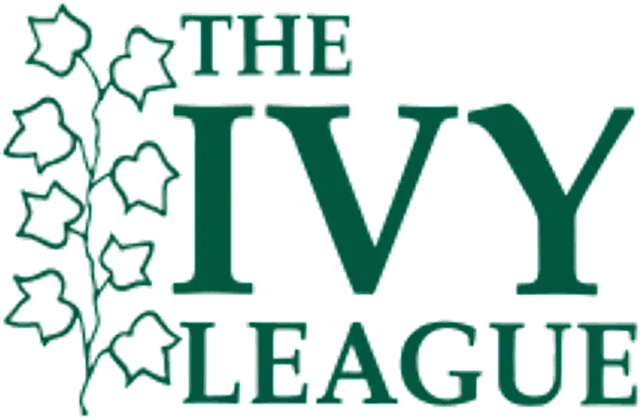
Ivy League

| Ivy League | |
|---|---|
| Established | 1954 |
| Association | NCAA |
| Division | Division I |
| Subdivision | FCS |
| Members | 8 |
| Sports fielded |
|
| Region | Northeast |
| Headquarters | Princeton, New Jersey |
| Commissioner | Robin Harris[2] (since 2009) |
| Website | ivyleague.com [150] |
| Locations | |
 | |
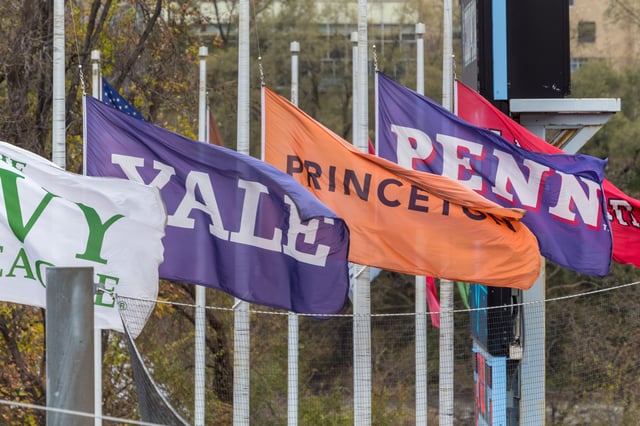
Flags of the Ivy League Universities fly over Columbia's Wien Stadium

Locations of Ivy League universities
The Ivy League is an American collegiate athletic conference comprising sports teams from eight private universities in the Northeastern United States. The term Ivy League is typically used to refer to those eight schools as a group of elite colleges beyond the sports context.[3] The eight members are Brown University, Columbia University, Cornell University, Dartmouth College, Harvard University, the University of Pennsylvania, Princeton University, and Yale University. Ivy League has connotations of academic excellence, selectivity in admissions, and social elitism.
While the term was in use as early as 1933, it became official only after the formation of the NCAA Division I athletic conference in 1954.[4] Seven of the eight schools were founded during the colonial period (Cornell was founded in 1865), and thus account for seven of the nine Colonial Colleges chartered before the American Revolution. The other two colonial colleges Rutgers University and the College of William & Mary became public institutions instead.
Ivy League schools are generally viewed as some of the most prestigious, and are ranked among the best universities worldwide by U.S. News & World Report.[5] All eight universities place in the top fourteen of the 2019 U.S. News & World Report national university rankings, including four Ivies in the top three (Columbia and Yale are tied for third).[6] In the 2019 U.S. News & World Report global university rankings, three Ivies rank in the top ten (Harvard 1st, Columbia 8th, and Princeton 9th) and six in the top twenty-three. Undergraduate-focused Ivies such as Brown University and Dartmouth College rank 99th and 197th, respectively.[7][8] U.S. News has named a member of the Ivy League as the best national university in each of the past 18 years ending with the 2018 rankings: Princeton eleven times, Harvard twice, and the two schools tied for first five times.
Undergraduate enrollments range from about 4,000 to 14,000,[9] making them larger than those of a typical private liberal arts college and smaller than a typical public state university. Total enrollments, including graduate students, range from approximately 6,400 at Dartmouth to over 20,000 at Columbia, Cornell, Harvard, and Penn. Ivy League financial endowments range from Brown's $3.5 billion to Harvard's $34.5 billion,[10] the largest financial endowment of any academic institution in the world.[11]
The Ivy League has drawn many comparisons to other elite grouping of universities in other nations such as Oxbridge[12][13] and the Golden Triangle in the United Kingdom, C9 League[14] in China, Group of Eight[15] in Australia, and Imperial Universities[16] in Japan. These counterparts are often referred to in the American media as the "Ivy League" of their respective nations. Additionally, groupings of schools use the "Ivy" nomenclature to denote a perceived comparability, such as American liberal arts colleges (Little Ivies), lesser known schools (Hidden Ivies), public universities (Public Ivies), and schools in the Southern United States (Southern Ivies).
| Ivy League | |
|---|---|
| Established | 1954 |
| Association | NCAA |
| Division | Division I |
| Subdivision | FCS |
| Members | 8 |
| Sports fielded |
|
| Region | Northeast |
| Headquarters | Princeton, New Jersey |
| Commissioner | Robin Harris[2] (since 2009) |
| Website | ivyleague.com [150] |
| Locations | |
 | |
Members
Ivy League universities have some of the largest university financial endowments in the world, which allows the universities to provide many resources for their academic programs and research endeavors. As of 2018, Harvard University has an endowment of $38.3 billion, the highest of any U.S. educational institution.[17] Additionally, each university receives millions of dollars in research grants and other subsidies from federal and state governments.
| Institution | Location | Athletic nickname | Undergraduates | Graduates | 2018 endowment | Academic staff | Colors |
|---|---|---|---|---|---|---|---|
| Brown University | Providence, Rhode Island | Bears | 6,670 | 3,061 | $3.60 billion[17] | 736[18] | |
| Columbia University | New York City, New York | Lions | 8,868 | 20,116 | $10.87 billion[17] | 3,763[19] | |
| Cornell University | Ithaca, New York | Big Red | 15,182 | 8,418 | $7.23 billion[17] | 2,908 | |
| Dartmouth College | Hanover, New Hampshire | Big Green | 4,310 | 2,099 | $5.49 billion[17] | 571 | |
| Harvard University | Cambridge, Massachusetts | Crimson | 6,699 | 13,120 | $38.30 billion[17] | 4,671[20] | |
| University of Pennsylvania | Philadelphia, Pennsylvania | Quakers | 10,496 | 11,013 | $13.78 billion[17] | 4,464[21] | |
| Princeton University | Princeton, New Jersey | Tigers | 5,394 | 2,879 | $25.92 billion[17] | 1,172 | |
| Yale University | New Haven, Connecticut | Bulldogs | 5,453 | 6,859 | $29.35 billion[17] | 4,140 |
History
Year founded
| Institution | Founded | Founding affiliation |
|---|---|---|
| Harvard University[22] | 1636 as New College | Calvinist (Congregationalist Puritans) |
| Yale University | 1701 as Collegiate School | Calvinist (Congregationalist) |
| University of Pennsylvania | 1740 as Unnamed Charity School[23] | Nonsectarian,[24] founded by Church of England/Methodists members[25][26] |
| Princeton University | 1746 as College of New Jersey | Nonsectarian,[27] founded by Calvinist Presbyterians[27] |
| Columbia University | 1754 as King's College | Church of England |
| Brown University | 1764 as the College in the English Colony of Rhode Island and Providence Plantations | Baptist, founding charter promises "no religious tests" and "full liberty of conscience"[28] |
| Dartmouth College | 1769 | Calvinist (Congregationalist) |
| Cornell University | 1865 | Nonsectarian |
- Note: Six of the eight Ivy League universities consider their founding dates to be simply the date that they received their charters and thus became legal corporations with the authority to grant academic degrees. Harvard University uses the date that the legislature of the Massachusetts Bay Colony formally allocated funds for the creation of a college. Harvard was chartered in 1650, although classes had been conducted for approximately a decade by then. The University of Pennsylvania initially considered its founding date to be 1750; this is the year which appears on the first iteration of the university seal.[29] Later in Penn's early history, the university changed its officially recognized founding date to 1749, which was used for all of the nineteenth century, including a centennial celebration in 1849. In 1899, Penn's board of trustees formally adopted a third founding date of 1740, in response to a petition from Penn's General Alumni Society. Penn was chartered in 1755, the same year collegiate classes began. "Religious affiliation" refers to financial sponsorship, formal association with, and promotion by, a religious denomination. All of the schools in the Ivy League are private and not currently associated with any religion.
Origin of the name
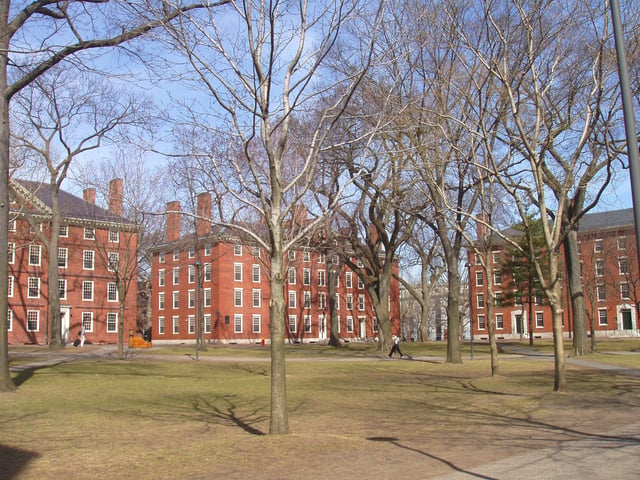
Harvard Yard, 2007: Hollis Hall, Stoughton Hall, and Holworthy Hall
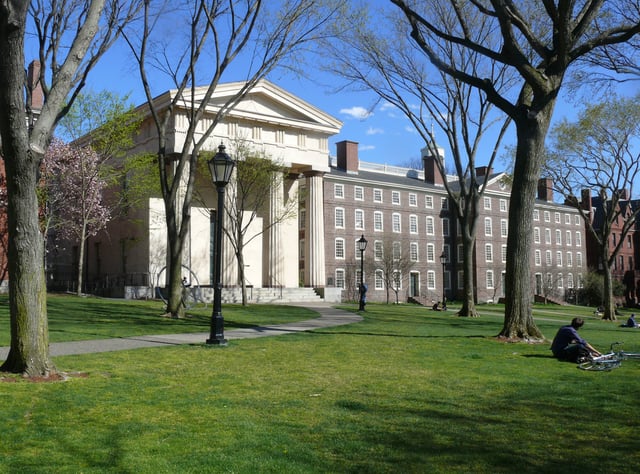
Brown's Front Green, 2012: Hope College, Manning Hall, University Hall, and Slater Hall
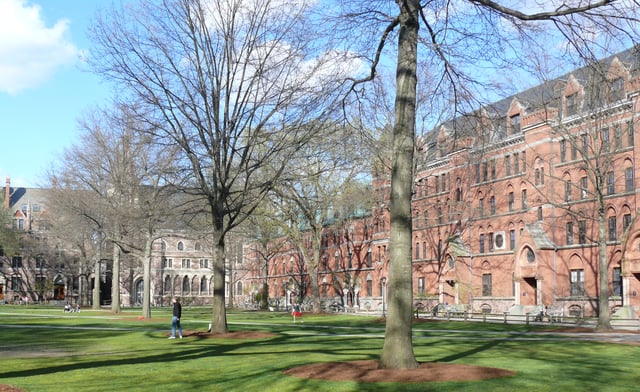
Yale's Old Campus, 2012: Durfee Hall, Battell Chapel, Farnham Hall, and Lawrence Hall
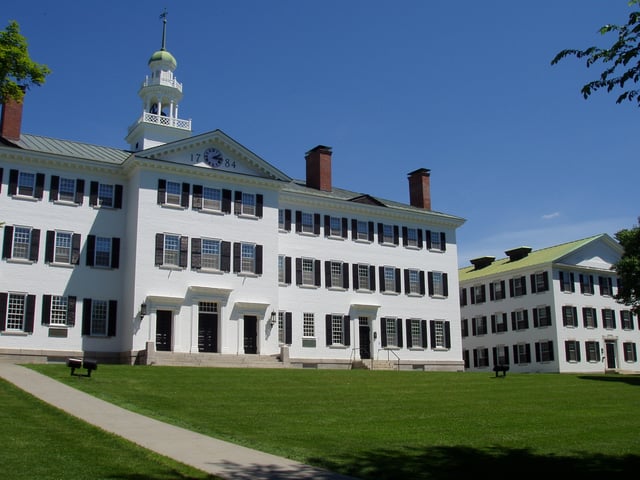
On the Dartmouth Green, 2007: Dartmouth Hall and Thornton Hall
Students have long revered the ivied walls of older colleges. "Planting the ivy" was a customary class day ceremony at many colleges in the 1800s. In 1893, an alumnus told The Harvard Crimson, "In 1850, class day was placed upon the University Calendar. ... the custom of planting the ivy, while the ivy oration was delivered, arose about this time."[30] At Penn, graduating seniors started the custom of planting ivy at a university building each spring in 1873 and that practice was formally designated as "Ivy Day" in 1874.[31] Ivy planting ceremonies are reported for Yale,[32] Simmons,[33] Bryn Mawr[34] and many others. Princeton's "Ivy Club" was founded in 1879.[35]
The first usage of Ivy in reference to a group of colleges is from sportswriter Stanley Woodward (1895–1965).
A proportion of our eastern ivy colleges are meeting little fellows another Saturday before plunging into the strife and the turmoil.— Stanley Woodward, New York Tribune, October 14, 1933, describing the football season[36]
The first known instance of the term Ivy League being used appeared in The Christian Science Monitor on February 7, 1935.[4][37][38] Several sportswriters and other journalists used the term shortly later to refer to the older colleges, those along the northeastern seaboard of the United States, chiefly the nine institutions with origins dating from the colonial era, together with the United States Military Academy (West Point), the United States Naval Academy, and a few others. These schools were known for their long-standing traditions in intercollegiate athletics, often being the first schools to participate in such activities. However, at this time, none of these institutions made efforts to form an athletic league.
A common folk etymology attributes the name to the Roman numeral for four (IV), asserting that there was such a sports league originally with four members. The Morris Dictionary of Word and Phrase Origins helped to perpetuate this belief. The supposed "IV League" was formed over a century ago and consisted of Harvard, Yale, Princeton, and a fourth school that varies depending on who is telling the story.[39][40][41] However, it is clear that Harvard, Princeton, Yale and Columbia met on November 23, 1876 at the so-called Massasoit Convention to decide on uniform rules for the emerging game of American football, which rapidly spread.[42]
Pre-Ivy League
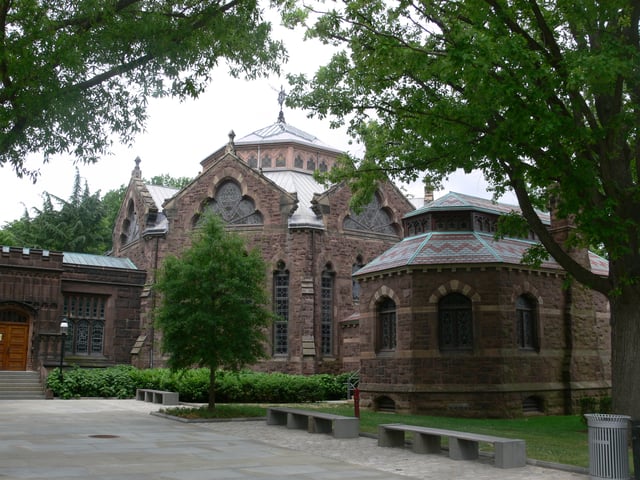
Chancellor Green Library at Princeton, 2007
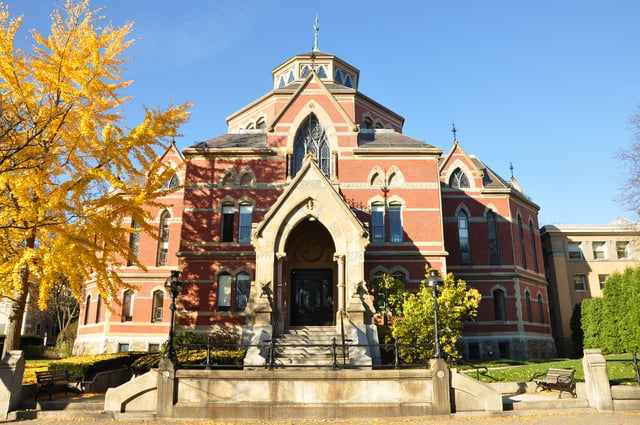
Robinson Hall at Brown, 2009
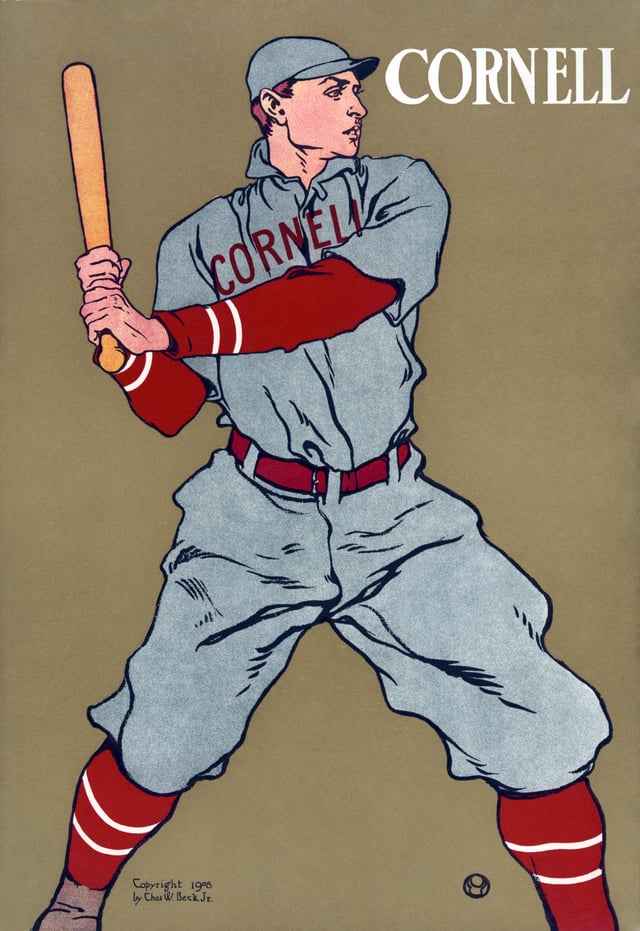
Cornell baseball player, 1908
Seven out of the eight Ivy League schools were founded before the American Revolution; Cornell was founded just after the American Civil War. These seven were the primary colleges in the Northern and Middle Colonies, and their early faculties and founding boards were largely drawn from other Ivy League institutions. There were also some British graduates from the University of Cambridge, the University of Oxford, the University of St. Andrews, the University of Edinburgh, and elsewhere on their boards. Similarly, the founder of The College of William & Mary, in 1693, was a British graduate of the University of Edinburgh. Cornell provided Stanford University with its first president.
The influence of these institutions on the founding of other colleges and universities is notable. This included the Southern public college movement which blossomed in the decades surrounding the turn of the 19th century when Georgia, South Carolina, North Carolina and Virginia established what became the flagship universities for each of these states. In 1801, a majority of the first board of trustees for what became the University of South Carolina were Princeton alumni. They appointed Jonathan Maxcy, a Brown graduate, as the university's first president. Thomas Cooper, an Oxford alumnus and University of Pennsylvania faculty member, became the second president of the South Carolina college. The founders of the University of California, Berkeley came from Yale, hence the school colors of University of California at Berkeley are Yale Blue and California Gold.[43]
Some of the Ivy League schools have identifiable Protestant roots, while others were founded as non-sectarian schools. Church of England King's College broke up during the Revolution and was reformed as public nonsectarian Columbia College. In the early nineteenth century, the specific purpose of training Calvinist ministers was handed off to theological seminaries, but a denominational tone and such relics as compulsory chapel often lasted well into the twentieth century. Penn and Brown were officially founded as nonsectarian schools. Brown's charter promised no religious tests and "full liberty of conscience", but placed control in the hands of a board of twenty-two Baptists, five Quakers, four Congregationalists, and five Episcopalians. Cornell has been strongly nonsectarian from its founding.
"Ivy League" is sometimes used as a way of referring to an elite class, even though institutions such as Cornell University were among the first in the United States to reject racial and gender discrimination in their admissions policies. This dates back to at least 1935.[44] Novels[45] and memoirs[46] attest this sense, as a social elite; to some degree independent of the actual schools.
After the Second World War, the present Ivy League institutions slowly widened their selection of their students. They had always had distinguished faculties; some of the first Americans with doctorates had taught for them; but they now decided that they could not both be world-class research institutions and be competitive in the highest ranks of American college sport; in addition, the schools experienced the scandals of any other big-time football programs, although more quietly.[47]
History of the athletic league
19th and early 20th centuries
The first formal athletic league involving eventual Ivy League schools (or any US colleges, for that matter) was created in 1870 with the formation of the Rowing Association of American Colleges. The RAAC hosted a de facto national championship in rowing during the period 1870–1894. In 1895, Cornell, Columbia, and Penn founded the Intercollegiate Rowing Association, which remains the oldest collegiate athletic organizing body in the US. To this day, the IRA Championship Regatta determines the national champion in rowing and all of the Ivies are regularly invited to compete.
A basketball league was later created in 1902, when Columbia, Cornell, Harvard, Yale and Princeton formed the Eastern Intercollegiate Basketball League; they were later joined by Penn and Dartmouth.
In 1906, the organization that eventually became the National Collegiate Athletic Association was formed, primarily to formalize rules for the emerging sport of football. But of the 39 original member colleges in the NCAA, only two of them (Dartmouth and Penn) later became Ivies.
In February 1903, intercollegiate wrestling began when Yale accepted a challenge from Columbia, published in the Yale News. The dual meet took place prior to a basketball game hosted by Columbia and resulted in a tie. Two years later, Penn and Princeton also added wrestling teams, leading to the formation of the student-run Intercollegiate Wrestling Association, now the Eastern Intercollegiate Wrestling Association (EIWA), the first and oldest collegiate wrestling league in the US.[49]
In 1930, Columbia, Cornell, Dartmouth, Penn, Princeton and Yale formed the Eastern Intercollegiate Baseball League; they were later joined by Harvard, Brown, Army and Navy.
Before the formal establishment of the Ivy League, there was an "unwritten and unspoken agreement among certain Eastern colleges on athletic relations". The earliest reference to the "Ivy colleges" came in 1933, when Stanley Woodward of the New York Herald Tribune used it to refer to the eight current members plus Army.[4] In 1935, the Associated Press reported on an example of collaboration between the schools:
The athletic authorities of the so-called "Ivy League" are considering drastic measures to curb the increasing tendency toward riotous attacks on goal posts and other encroachments by spectators on playing fields.— The Associated Press, The New York Times[50]
Despite such collaboration, the universities did not seem to consider the formation of the league as imminent. Romeyn Berry, Cornell's manager of athletics, reported the situation in January 1936 as follows:
I can say with certainty that in the last five years—and markedly in the last three months—there has been a strong drift among the eight or ten universities of the East which see a good deal of one another in sport toward a closer bond of confidence and cooperation and toward the formation of a common front against the threat of a breakdown in the ideals of amateur sport in the interests of supposed expediency. Please do not regard that statement as implying the organization of an Eastern conference or even a poetic "Ivy League". That sort of thing does not seem to be in the cards at the moment.[51]
Within a year of this statement and having held month-long discussions about the proposal, on December 3, 1936, the idea of "the formation of an Ivy League" gained enough traction among the undergraduate bodies of the universities that the Columbia Daily Spectator, The Cornell Daily Sun, The Dartmouth, The Harvard Crimson, The Daily Pennsylvanian, The Daily Princetonian and the Yale Daily News would simultaneously run an editorial entitled "Now Is the Time", encouraging the seven universities to form the league in an effort to preserve the ideals of athletics.[52] Part of the editorial read as follows:
The Ivy League exists already in the minds of a good many of those connected with football, and we fail to see why the seven schools concerned should be satisfied to let it exist as a purely nebulous entity where there are so many practical benefits which would be possible under definite organized association. The seven colleges involved fall naturally together by reason of their common interests and similar general standards and by dint of their established national reputation they are in a particularly advantageous position to assume leadership for the preservation of the ideals of intercollegiate athletics.[53]
The Ivies have been competing in sports as long as intercollegiate sports have existed in the United States. Rowing teams from Harvard and Yale met in the first sporting event held between students of two U.S. colleges on Lake Winnipesaukee, New Hampshire, on August 3, 1852. Harvard's team, "The Oneida", won the race and was presented with trophy black walnut oars from then presidential nominee General Franklin Pierce. The proposal did not succeed—on January 11, 1937, the athletic authorities at the schools rejected the "possibility of a heptagonal league in football such as these institutions maintain in basketball, baseball and track." However, they noted that the league "has such promising possibilities that it may not be dismissed and must be the subject of further consideration."[54]
Post-World War II
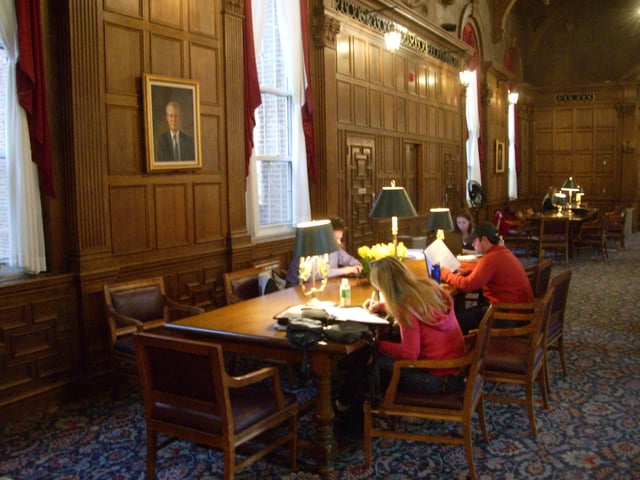
Students in Stell Hall at Dartmouth's Tuck School of Business, 2007
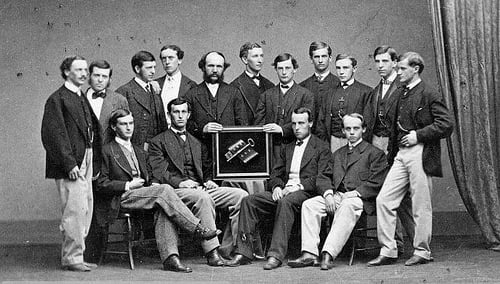
Students of Yale College, 1866
In 1945 the presidents of the eight schools signed the first Ivy Group Agreement, which set academic, financial, and athletic standards for the football teams. The principles established reiterated those put forward in the Harvard-Yale-Princeton Presidents' Agreement of 1916. The Ivy Group Agreement established the core tenet that an applicant's ability to play on a team would not influence admissions decisions:
The members of the Group reaffirm their prohibition of athletic scholarships. Athletes shall be admitted as students and awarded financial aid only on the basis of the same academic standards and economic need as are applied to all other students.[55]
In 1954, the presidents extended the Ivy Group Agreement to all intercollegiate sports, effective with the 1955–56 basketball season. This is generally reckoned as the formal formation of the Ivy League. As part of the transition, Brown, the only Ivy that hadn't joined the EIBL, did so for the 1954–55 season. A year later, the Ivy League absorbed the EIBL. The Ivy League claims the EIBL's history as its own. Through the EIBL, it is the oldest basketball conference in Division I.[56][57]
As late as the 1960s many of the Ivy League universities' undergraduate programs remained open only to men, with Cornell the only one to have been coeducational from its founding (1865) and Columbia being the last (1983) to become coeducational. Before they became coeducational, many of the Ivy schools maintained extensive social ties with nearby Seven Sisters women's colleges, including weekend visits, dances and parties inviting Ivy and Seven Sisters students to mingle. This was the case not only at Barnard College and Radcliffe College, which are adjacent to Columbia and Harvard, but at more distant institutions as well. The movie Animal House includes a satiric version of the formerly common visits by Dartmouth men to Massachusetts to meet Smith and Mount Holyoke women, a drive of more than two hours. As noted by Irene Harwarth, Mindi Maline, and Elizabeth DeBra, "The 'Seven Sisters' was the name given to Barnard, Smith, Mount Holyoke, Vassar, Bryn Mawr, Wellesley, and Radcliffe, because of their parallel to the Ivy League men's colleges."[58]
In 1982 the Ivy League considered adding two members, with Army, Navy, and Northwestern as the most likely candidates; if it had done so, the league could probably have avoided being moved into the recently created Division I-AA (now Division I FCS) for football.[59] In 1983, following the admission of women to Columbia College, Columbia University and Barnard College entered into an athletic consortium agreement by which students from both schools compete together on Columbia University women's athletic teams, which replaced the women's teams previously sponsored by Barnard.
When Army and Navy departed the Eastern Intercollegiate Baseball League in 1992, nearly all intercollegiate competition involving the eight schools became united under the Ivy League banner. The only major exception is wrestling; the Ivies that sponsor wrestling—all except Dartmouth and Yale—are part of the EIWA.
Academics
Admissions
The Ivy League schools are highly selective, with acceptance rates since 2018 being 10% or less at each of the universities. Admitted students come from around the world, although students from New England and the Northeastern United States make up a significant proportion of students.[68][69][70] In 2018, seven of the eight Ivy League schools reported record-high application numbers; seven also reported record-low acceptance rates.[71]
Prestige
Members of the League have been highly ranked by various university rankings. In addition to the broad rankings listed in the accompanying chart, several Ivy League schools are highly ranked in the current 2018 US News & World Report assessment of Best Undergraduate Teaching: 1. Princeton; 2. Dartmouth; 3. Brown; 10. Yale. The Wall Street Journal rankings place all eight of the universities within the top 20 in the country.[72]
Further, Ivy League members have produced many Nobel laureates, winners of the Nobel Prize and the Nobel Memorial Prize in Economic Sciences. According to the Nobel Foundation's website, as of 2016 the number of prize-winners affiliated with each Ivy League university at the time of their awards is: Brown, 2; Columbia, 17; Cornell, 8; Dartmouth, 0; Harvard, 36; Penn, 4; Princeton, 14; and Yale, 8.[77] In addition, each university self-reports their number of affiliated Nobel laureates, but they use varying definitions for which Nobel winners they claim (for example, alumni, active faculty, former faculty, visiting faculty, adjunct faculty, etc.)
Collaboration
Collaboration between the member schools is illustrated by the student-led Ivy Council that meets in the fall and spring of each year, with representatives from every Ivy League school. The governing body of the Ivy League is the Council of Ivy Group Presidents, composed of each university president. During meetings, the presidents often discuss common procedures and initiatives for the universities.
The universities also collaborate academically through the IvyPlus Exchange program, which allows students to cross-register at one of the Ivies or one of the eligible schools, which include the University of California at Berkeley, University of Chicago, the Massachusetts Institute of Technology, and Stanford University.[78]
Culture
Fashion and lifestyle
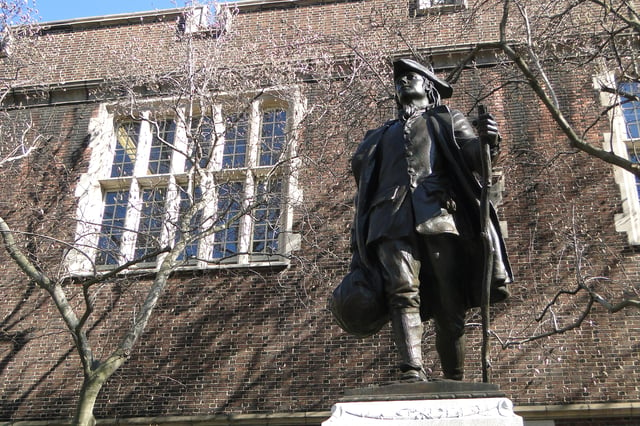
Statue of Benjamin Franklin on the campus of the University of Pennsylvania, 2011
Different fashion trends and styles have emerged from Ivy League campuses over time, and fashion trends such as Ivy League and Preppy are styles often associated with the Ivy League and its culture.
Ivy League style is a style of men's dress, popular during the late 1950s, believed to have originated on Ivy League campuses. The clothing stores J. Press and Brooks Brothers represent perhaps the quintessential Ivy League dress manner. The Ivy League style is said to be the predecessor to the preppy style of dress.
Preppy fashion started around 1912 to the late 1940s and 1950s as the Ivy League style of dress.[79] J. Press represents the quintessential preppy clothing brand, stemming from the collegiate traditions that shaped the preppy subculture. In the mid-twentieth century J. Press and Brooks Brothers, both being pioneers in preppy fashion, had stores on Ivy League school campuses, including Harvard, Princeton, and Yale.
Some typical preppy styles also reflect traditional upper class New England leisure activities, such as equestrian, sailing or yachting, hunting, fencing, rowing, lacrosse, tennis, golf, and rugby. Longtime New England outdoor outfitters, such as L.L. Bean,[80] became part of conventional preppy style. This can be seen in sport stripes and colours, equestrian clothing, plaid shirts, field jackets and nautical-themed accessories. Vacationing in Palm Beach, Florida, long popular with the East Coast upper class, led to the emergence of bright colour combinations in leisure wear seen in some brands such as Lilly Pulitzer.[80] By the 1980s, other brands such as Lacoste, Izod[81] and Dooney & Bourke became associated with preppy style.
Social elitism
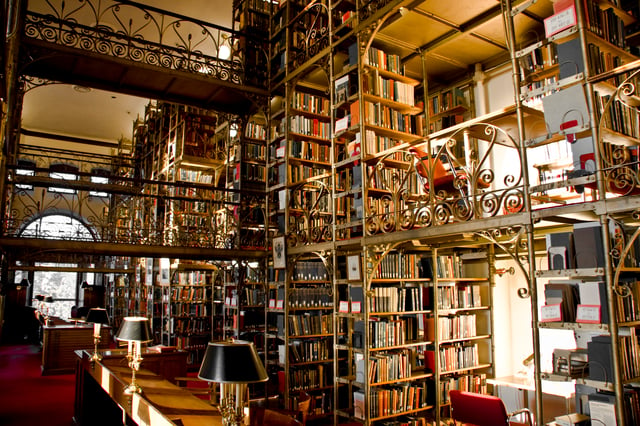
The A.D. White Reading Room at Cornell's Uris Library, 2008
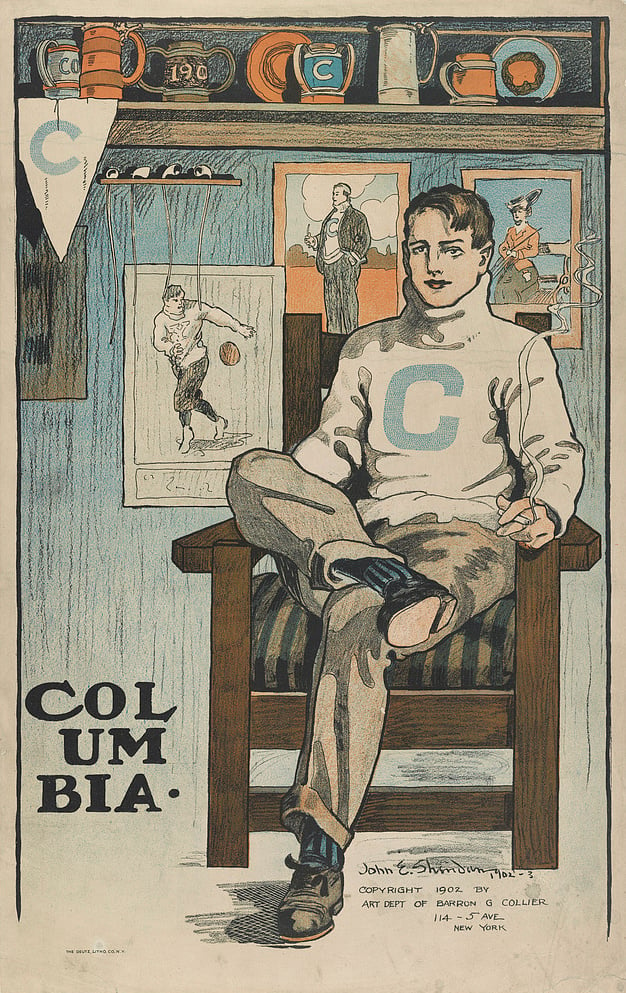
A cartoon portrait of the stereotypical Columbia man, 1902
The Ivy League is often associated with the upper class White Anglo-Saxon Protestant community of the Northeast, Old Money, or more generally, the American upper middle and upper classes.[84][85][86][87] Although most Ivy League students come from upper middle- and upper-class families, the student body has become increasingly more economically and ethnically diverse. The universities provide significant financial aid to help increase the enrollment of lower income and middle class students.[88] Several reports suggest, however, that the proportion of students from less-affluent families remains low.[89][90]
Phrases such as "Ivy League snobbery"[91] are ubiquitous in nonfiction and fiction writing of the early and mid-twentieth century. A Louis Auchincloss character dreads "the aridity of snobbery which he knew infected the Ivy League colleges".[45] A business writer, warning in 2001 against discriminatory hiring, presented a cautionary example of an attitude to avoid (the bracketed phrase is his):
We Ivy Leaguers [read: mostly white and Anglo] know that an Ivy League degree is a mark of the kind of person who is likely to succeed in this organization.[92]
The phrase Ivy League historically has been perceived as connected not only with academic excellence, but also with social elitism. In 1936, sportswriter John Kieran noted that student editors at Harvard, Yale, Princeton, Cornell, Columbia, Dartmouth, and Penn were advocating the formation of an athletic association. In urging them to consider "Army and Navy and Georgetown and Fordham and Syracuse and Brown and Pitt" as candidates for membership, he exhorted:
It would be well for the proponents of the Ivy League to make it clear (to themselves especially) that the proposed group would be inclusive but not "exclusive" as this term is used with a slight up-tilting of the tip of the nose.[93]
Aspects of Ivy stereotyping were illustrated during the 1988 presidential election, when George H. W. Bush (Yale '48) derided Michael Dukakis (graduate of Harvard Law School) for having "foreign-policy views born in Harvard Yard's boutique."[94] New York Times columnist Maureen Dowd asked "Wasn't this a case of the pot calling the kettle elite?" Bush explained, however, that, unlike Harvard, Yale's reputation was "so diffuse, there isn't a symbol, I don't think, in the Yale situation, any symbolism in it. ... Harvard boutique to me has the connotation of liberalism and elitism" and said Harvard in his remark was intended to represent "a philosophical enclave" and not a statement about class.[95] Columnist Russell Baker opined that "Voters inclined to loathe and fear elite Ivy League schools rarely make fine distinctions between Yale and Harvard. All they know is that both are full of rich, fancy, stuck-up and possibly dangerous intellectuals who never sit down to supper in their undershirt no matter how hot the weather gets."[96] Still, the last five presidents have all attended Ivy League schools for at least part of their education— George H. W. Bush (Yale undergrad), Bill Clinton (Yale Law School), George W. Bush (Yale undergrad, Harvard Business School), Barack Obama (Columbia undergrad, Harvard Law School), and Donald Trump (Penn undergrad).
U.S. presidents in the Ivy League
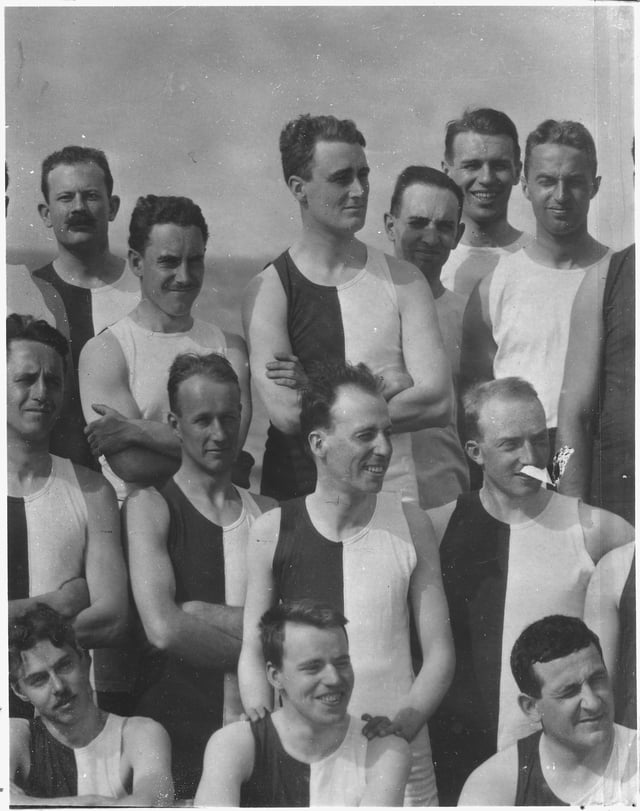
Franklin Delano Roosevelt, third from left, top row, with his Harvard class in 1904
Of the 44 men who have served as President of the United States, 16 have graduated from an Ivy League university. Of them, eight have degrees from Harvard, five from Yale, three from Columbia, two from Princeton and one from Penn. Twelve presidents have earned Ivy undergraduate degrees. Three of these were transfer students: Donald Trump transferred from Fordham University; Barack Obama transferred from Occidental College; and John F. Kennedy transferred from another Ivy, Princeton, where he had been class of 1939. John Adams was the first president to graduate from college, graduating from Harvard in 1755.
| President | School(s) | Graduation year |
|---|---|---|
| John Adams | Harvard University | 1755 |
| James Madison | Princeton University | 1771 |
| John Quincy Adams | Harvard University | 1787 |
| William Henry Harrison | University of Pennsylvania | (withdrew) |
| Rutherford B. Hayes | Harvard Law School | 1845 |
| Theodore Roosevelt | Harvard University Columbia Law School | 1880 (withdrew) (Awarded J.D. in 2008, class of 1882)[97] |
| William Howard Taft | Yale University | 1878 |
| Woodrow Wilson | Princeton University | 1879 |
| Franklin D. Roosevelt | Harvard University Columbia Law School | 1903 (withdrew) (Awarded J.D. in 2008, class of 1907)[98] |
| John F. Kennedy | Princeton University Harvard University | (withdrew) 1940 |
| Gerald Ford | Yale Law School | 1941 |
| George H. W. Bush | Yale University | 1948 |
| Bill Clinton | Yale Law School | 1973 |
| George W. Bush | Yale University Harvard Business School | 1968 1975 |
| Barack Obama | Columbia University Harvard Law School | 1983 1991 |
| Donald Trump | University of Pennsylvania | 1968 |
Student demographics
| Asian | Black | Hispanic (of any race) | Non-Hispanic White | Other/ international | Unknown | |
|---|---|---|---|---|---|---|
| Brown | 14% | 6% | 10% | 45% | 14% | 11% |
| Columbia | 15% | 8% | 13% | 41% | 17% | 6% |
| Cornell | 17% | 6% | 10% | 46% | 13% | 10% |
| Dartmouth | 14% | 8% | 9% | 48% | 13% | 8% |
| Harvard | 12% | 7% | 9% | 45% | 22% | 6% |
| Penn | 19% | 7% | 8% | 46% | 13% | 7% |
| Princeton | 18% | 7% | 8% | 49% | 15% | 3% |
| Yale | 15% | 6% | 8% | 58% | 5% | 8% |
| United States[100] | 5% | 13% | 17% | 63% | 4% | NA |
Geographic distribution
Students of the Ivy League largely hail from the Northeast, largely from the New York City, Boston, and Philadelphia areas. As all eight Ivy League universities are within the Northeast, it is no surprise that most graduates end up working and residing in the Northeast after graduation. An unscientific survey of Harvard seniors from the Class of 2013 found that 42% hailed from the Northeast and 55% overall were planning on working and residing in the Northeast.[101] Boston and New York City are traditionally where many Ivy League graduates end up living.[102][103]
Socioeconomics and social class
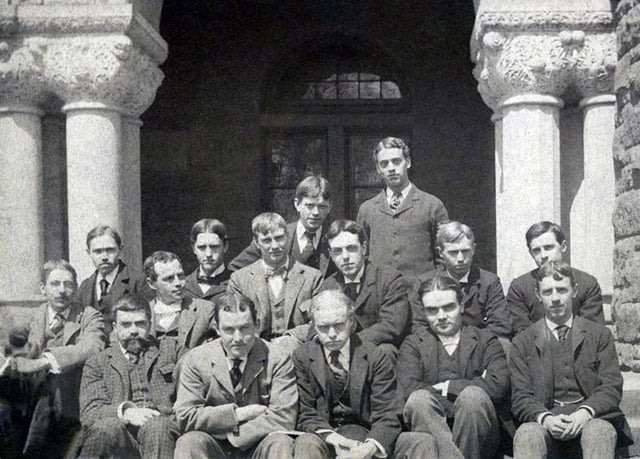
Harvard Law School students circa 1895
Students of the Ivy League, both graduate and undergraduate, come primarily from upper middle and upper class families. In recent years, however, the universities have looked towards increasing socioeconomic and class diversity, by providing greater financial aid packages to applicants from lower, working, and middle class American families.[88][104]
In 2013, 46% of Harvard undergraduate students came from families in the top 3.8% of all American households (i.e., over $200,000 annual income).[104] In 2012, the bottom 25% of the American income distribution accounted for only 3–4% of students at Brown, a figure that had remained unchanged since 1992.[105] In 2014, 69% of incoming freshmen students at Yale College came from families with annual incomes of over $120,000, putting most Yale College students in the upper middle and/or upper class. (The median household income in the U.S. in 2013 was $52,700.)[106]
In the 2011–2012 academic year, students qualifying for Pell Grants (federally funded scholarships on the basis of need) comprised 20% at Harvard, 18% at Cornell, 17% at Penn, 16% at Columbia, 15% at Dartmouth and Brown, 14% at Yale, and 12% at Princeton. Nationally, 35% of American university students qualify for a Pell Grant.[107]
Competition and athletics
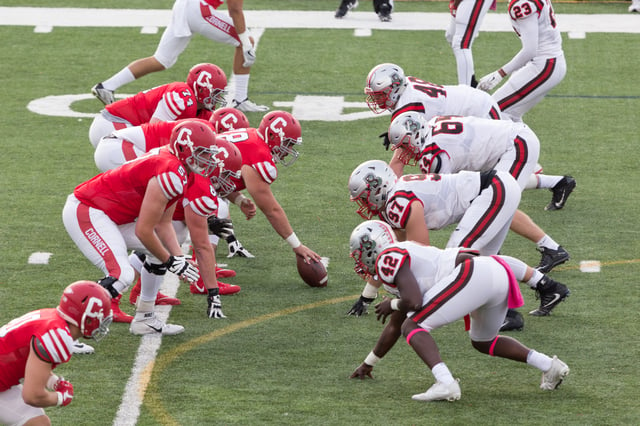
Brown (right) plays at Cornell's Homecoming game, October 2017.
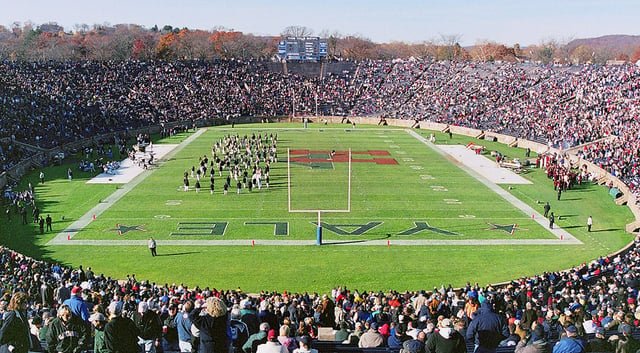
The Yale Bowl in 2001 during the annual football game played between Harvard and Yale
Ivy champions are recognized in sixteen men's and sixteen women's sports. In some sports, Ivy teams actually compete as members of another league, the Ivy championship being decided by isolating the members' records in play against each other; for example, the six league members who participate in ice hockey do so as members of ECAC Hockey, but an Ivy champion is extrapolated each year. In one sport, rowing, the Ivies recognize team champions for each sex in both heavyweight and lightweight divisions. While the Intercollegiate Rowing Association governs all four sex- and bodyweight-based divisions of rowing, the only one that is sanctioned by the NCAA is women's heavyweight. The Ivy League was the last Division I basketball conference to institute a conference postseason tournament; the first tournaments for men and women were held at the end of the 2016–17 season. The tournaments only award the Ivy League automatic bids for the NCAA Division I Men's and Women's Basketball Tournaments; the official conference championships continue to be awarded based solely on regular-season results.[108] Before the 2016–17 season, the automatic bids were based solely on regular-season record, with a one-game playoff (or series of one-game playoffs if more than two teams were tied) held to determine the automatic bid.[109] The Ivy League is one of only two Division I conferences which award their official basketball championships solely on regular-season results; the other is the Southeastern Conference.[110][111] Since its inception, an Ivy League school has yet to win either the men's or women's Division I NCAA Basketball Tournament.
On average, each Ivy school has more than 35 varsity teams. All eight are in the top 20 for number of sports offered for both men and women among Division I schools. Unlike most Division I athletic conferences, the Ivy League prohibits the granting of athletic scholarships; all scholarships awarded are need-based (financial aid).[112] In addition, the Ivies have a rigid policy against redshirting, even for medical reasons; an athlete loses a year of eligibility for every year enrolled at an Ivy institution.[113] Ivy League teams' non-league games are often against the members of the Patriot League, which have similar academic standards and athletic scholarship policies (although unlike the Ivies, the Patriot League allows redshirting).
In the time before recruiting for college sports became dominated by those offering athletic scholarships and lowered academic standards for athletes, the Ivy League was successful in many sports relative to other universities in the country. In particular, Princeton won 26 recognized national championships in college football (last in 1935), and Yale won 18 (last in 1927).[114] Both of these totals are considerably higher than those of other historically strong programs such as Alabama, which has won 15, Notre Dame, which claims 11 but is credited by many sources with 13, and USC, which has won 11. Yale, whose coach Walter Camp was the "Father of American Football," held on to its place as the all-time wins leader in college football throughout the entire 20th century, but was finally passed by Michigan on November 10, 2001. Harvard, Yale, Princeton and Penn each have over a dozen former scholar-athletes enshrined in the College Football Hall of Fame. Currently Dartmouth holds the record for most Ivy League football titles, with 18, followed closely by Harvard and Penn, each with 17 titles. In addition, the Ivy League has produced Super Bowl winners Kevin Boothe (Cornell), two-time Pro Bowler Zak DeOssie (Brown), Sean Morey (Brown), All-Pro selection Matt Birk (Harvard), Calvin Hill (Yale), Derrick Harmon (Cornell) and 1999 "Mr. Irrelevant" Jim Finn (Penn).
Beginning with the 1982 football season, the Ivy League has competed in Division I-AA (renamed FCS in 2006).[115][116] The Ivy League teams are eligible for the FCS tournament held to determine the national champion, and the league champion is eligible for an automatic bid (and any other team may qualify for an at-large selection) from the NCAA. However, since its inception in 1956, the Ivy League has not played any postseason games due to concerns about the extended December schedule's effects on academics. (The last postseason game for a member was 85 years ago, the 1934 Rose Bowl, won by Columbia.)[117][118] For this reason, any Ivy League team invited to the FCS playoffs turns down the bid. The Ivy League plays a strict 10-game schedule, compared to other FCS members' schedules of 11 (or, in some seasons, 12) regular season games, plus post-season, which expanded in 2013 to five rounds with 24 teams, with a bye week for the top eight teams. Football is the only sport in which the Ivy League declines to compete for a national title.
In addition to varsity football, Penn, Princeton and Cornell also field teams in the 10-team Collegiate Sprint Football League, in which all players must weigh 178 pounds or less. Penn and Princeton are the last remaining founding members of the league from its 1934 debut, and Cornell is the next-oldest, joining in 1937. Yale and Columbia previously fielded teams in the league but no longer do so.
Teams
| Sport | Men's | Women's |
|---|---|---|
| Baseball | 8 | |
| Basketball | 8 | 8 |
| Cross-country | 8 | 8 |
| Fencing | 6 | 7 |
| Field hockey | 8 | |
| Football | 8 | |
| Golf | 8 | 7 |
| Ice hockey | 6 | 6 |
| Lacrosse | 7 | 8 |
| Rowing | 7 | 7 |
| Soccer | 8 | 8 |
| Softball | 8 | |
| Squash | 8 | 8 |
| Swimming and diving | 7 | 8 |
| Tennis | 8 | 8 |
| Track and field (indoor) | 8 | 8 |
| Track and field (outdoor) | 8 | 8 |
| Volleyball | 8 | |
| Wrestling | 6 |
The Ivy League is home to some of the oldest college rugby teams in the United States. Although these teams are not "varsity" sports, they compete annually in the Ivy Rugby Conference.
Historical results
| Institution | Ivy League Championships | NCAA Team Championships |
|---|---|---|
| Princeton University Tigers | 476 | 12 |
| Harvard University Crimson | 415 | 4 |
| Cornell University Big Red | 231 | 5 |
| University of Pennsylvania Quakers | 210 | 3 |
| Yale University Bulldogs | 202 | 3 |
| Dartmouth College Big Green | 140 | 3 |
| Brown University Bears | 123 | 7 |
| Columbia University Lions | 105 | 11 |
The table above includes the number of team championships won from the beginning of official Ivy League competition (1956–57 academic year) through 2016–17. Princeton and Harvard have on occasion won ten or more Ivy League titles in a year, an achievement accomplished 10 times by Harvard and 24 times by Princeton, including a conference-record 15 championships in 2010–11. Only once has one of the other six schools earned more than eight titles in a single academic year (Cornell with nine in 2005–06). In the 38 academic years beginning 1979–80, Princeton has averaged 10 championships per year, one-third of the conference total of 33 sponsored sports.[120]
In the 12 academic years beginning 2005–06 Princeton has won championships in 31 different sports, all except wrestling and men's tennis.[121]
Rivalries
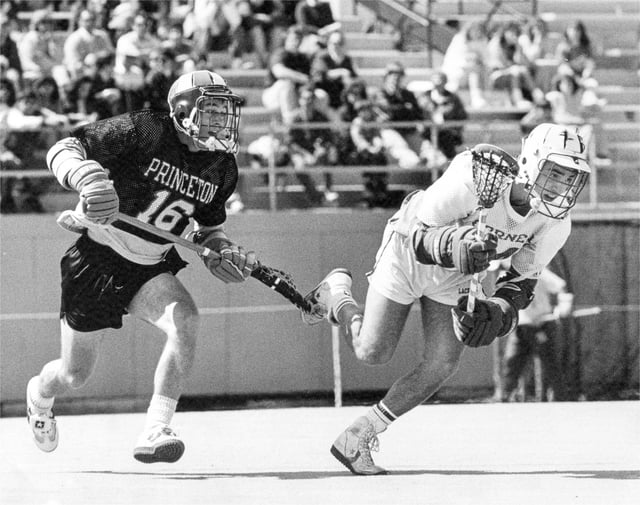
Cornell and Princeton are longtime lacrosse rivals

Built in 1927, Penn's Palestra is shown around 2006
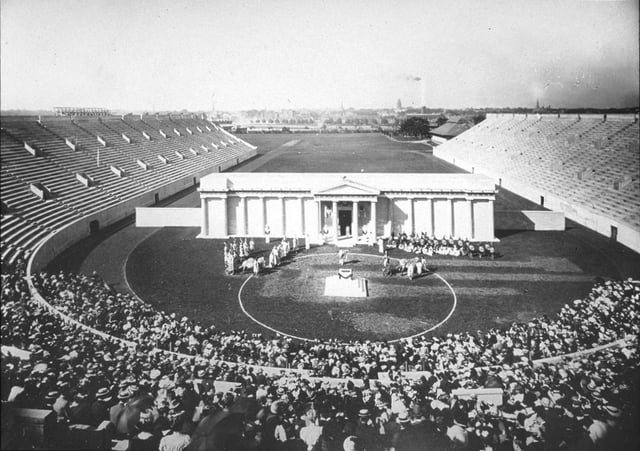
Performance of a Greek play at Harvard Stadium in 1903
Rivalries run deep in the Ivy League. For instance, Princeton and Penn are longstanding men's basketball rivals;[122] "Puck Frinceton" T-shirts are worn by Quaker fans at games.[123] In only 11 instances in the history of Ivy League basketball, and in only seven seasons since Yale's 1962 title, has neither Penn nor Princeton won at least a share of the Ivy League title in basketball,[124] with Princeton champion or co-champion 26 times and Penn 25 times. Penn has won 21 outright, Princeton 19 outright. Princeton has been a co-champion 7 times, sharing 4 of those titles with Penn (these 4 seasons represent the only times Penn has been co-champion). Harvard won its first title of either variety in 2011, losing a dramatic play-off game to Princeton for the NCAA tournament bid, then rebounded to win outright championships in 2012, 2013, and 2014. Harvard also won the 2013 Great Alaska Shootout, defeating TCU to become the only Ivy League school to win the now-defunct tournament.
Rivalries exist between other Ivy league teams in other sports, including Cornell and Harvard in hockey, Harvard and Princeton in swimming, and Harvard and Penn in football (Penn and Harvard have won 28 Ivy League Football Championships since 1982, Penn-16; Harvard-12). During that time Penn has had 8 undefeated Ivy League Football Championships and Harvard has had 6 undefeated Ivy League Football Championships.[125] In men's lacrosse, Cornell and Princeton are perennial rivals, and they are two of three Ivy League teams to have won the NCAA tournament.[126] In 2009, the Big Red and Tigers met for their 70th game in the NCAA tournament.[127] No team other than Harvard or Princeton has won the men's swimming conference title outright since 1972, although Yale, Columbia, and Cornell have shared the title with Harvard and Princeton during this time. Similarly, no program other than Princeton and Harvard has won the women's swimming championship since Brown's 1999 title. Princeton or Cornell has won every indoor and outdoor track and field championship, both men's and women's, every year since 2002–03, with one exception (Columbia women won indoor championship in 2012). Harvard and Yale are football and crew rivals although the competition has become unbalanced; Harvard has won all but one of the last 15 football games and all but one of the last 13 crew races.
Intra-conference football rivalries
| Teams | Name | Trophy | First met | Games played | Series record |
|---|---|---|---|---|---|
| Columbia-Cornell | Empire State Bowl | Empire Cup | 1889 | 103 games | 36–64–3 |
| Cornell-Penn | None | Trustee's Cup | 1893 | 122 games | 46–71–5 |
| Dartmouth-Princeton | None | Sawhorse Dollar | 1897 | 95 games | 48–43–4 |
| Harvard-Yale | The Game | None | 1875 | 132 games | 59–65–8 |
| Princeton-Yale | None | None | 1873 | 138 games | 52–76–10 |
The Yale-Princeton series is the nation's second longest, exceeded only by "The Rivalry" between Lehigh and Lafayette, which began later in 1884 but included two or three games in each of 17 early seasons.[128] For the first three decades of the Yale-Princeton rivalry, the two played their season-ending game at a neutral site, usually New York City, and with one exception (1890: Harvard), the winner of the game also won at least a share of the national championship that year, covering the period 1869 through 1903.[129][130] This phenomenon of a finale contest at a neutral site for the national title created a social occasion for the society elite of the metropolitan area akin to a Super Bowl in the era prior to the establishment of the NFL in 1920.[131][132] These football games were also financially profitable for the two universities, so much that they began to play baseball games in New York City as well, drawing record crowds for that sport also, largely from the same social demographic.[133] In a period when the only professional sports were fledgling baseball leagues, these high-profile early contests between Princeton and Yale played a role in popularizing spectator sports, demonstrating their financial potential and raising public awareness of Ivy universities at a time when few people attended college.
Extra-conference football rivalries
| Teams | Name | Trophy | First met | Games played | Series record |
|---|---|---|---|---|---|
| Brown-Rhode Island | None | Governor's Cup | 1909 | 98 games | 70–26–2 |
| Columbia-Fordham | None | Liberty Cup | 1890 | 24 games | 12–12–0 |
| Cornell-Colgate | None | None | 1896 | 95 games | 48–44–3 |
| Dartmouth-New Hampshire | Granite Bowl | Granite Bowl Trophy | 1901 | 37 games | 17–18–2 |
| Harvard-Holy Cross | None | None | 1904 | 67 games | 41–24–2 |
| Penn-Lafayette | None | None | 1882 | 90 games | 63–23–4 |
| Penn-Lehigh | None | None | 1885 | 56 games | 43–13 |
| Princeton-Rutgers | None | None | 1869 | 71 games | 53–17–1 |
| Yale-Army | None | None | 1893 | 45 games | 22–16–8 |
Championships
NCAA team championships
This list, which is current through July 1, 2015,[134] includes NCAA championships and women's AIAW championships (one each for Yale and Dartmouth). Excluded from this list are all other national championships earned outside the scope of NCAA competition, including football titles and retroactive Helms Foundation titles.
| School | Total | Men | Women | Co-ed | Nickname |
|---|---|---|---|---|---|
| Yale University | 29[1] | 26 | 3 | 0 | Bulldogs |
| Princeton University | 24[1] | 19 | 4 | 1 | Tigers |
| Columbia University | 14 | 11 | 0 | 3 | Lions |
| Harvard University | 10[1] | 7 | 2 | 1 | Crimson |
| Brown University | 7 | 0 | 7 | 0 | Bears |
| Cornell University | 5 | 5 | 0 | 0 | Big Red |
| Dartmouth College | 5[1] | 1 | 1 | 3 | Big Green |
| University of Pennsylvania | 4 | 3 | 1 | 0 | Quakers |
Athletic facilities
| Football stadium | Basketball arena | Baseball field | Hockey rink | Soccer stadium | |||||||||||
|---|---|---|---|---|---|---|---|---|---|---|---|---|---|---|---|
| School[135] | Name | Capacity | Year | Name | Capacity | Year | Name | Capacity | Year | Name | Capacity | Year | Name | Capacity | Year |
| Brown | Brown Stadium | 20,000 | 1925 | Pizzitola Sports Center | 2,800 | 1989 | Murray Stadium | 1,000 | 1959 | Meehan Auditorium | 3,100 | 1961 | Stevenson Field | 3,500 | 1979 |
| Columbia | Wien Stadium | 17,000 | 1984 | Levien Gymnasium | 3,408 | 1974 | Hal Robertson Field at Phillip Satow Stadium | 1,500 | 1923 | Non-hockey school | Commisso Soccer Stadium | 3,500 | 1985 | ||
| Cornell | Schoellkopf Field | 25,597 | 1915 | Newman Arena | 4,472 | 1990 | Hoy Field | 500 | 1922 | Lynah Rink | 4,267 | 1957 | Charles F. Berman Field | 1,000 | 2000 |
| Dartmouth | Memorial Field | 15,600 | 1923 | Leede Arena | 2,100 | 1986 | Red Rolfe Field at Biondi Park | 2,000 | 2008 | Thompson Arena | 4,500 | 1975 | Burnham Field | 1,600 | 2007 |
| Harvard | Harvard Stadium | 30,898 | 1903 | Lavietes Pavilion | 2,195 | 1926 | Joseph J. O'Donnell Field | 1,600 | 1898 | Bright Hockey Center | 2,850 | 1956 | Soldiers Field Soccer Stadium | 2,500 | 2010 |
| Penn | Franklin Field | 52,593 | 1895 | The Palestra | 8,722 | 1927 | Meiklejohn Stadium | 850 | 2000 | Class of 1923 Arena | 2,500 | 1972 | Rhodes Field | 1,700 | 2002[136] |
| Princeton | Princeton University Stadium | 27,800 | 1998 | Jadwin Gymnasium | 6,854 | 1969 | Bill Clarke Field | 850 | 1961 | Hobey Baker Memorial Rink | 2,094 | 1923 | Roberts Stadium | 3,000 | 2008 |
| Yale | Yale Bowl | 61,446 | 1914 | Payne Whitney Gymnasium | 3,100 | 1932 | Yale Field | 6,200 | 1927 | Ingalls Rink | 3,486 | 1958 | Reese Stadium | 3,000 | 1981 |
Other Ivies
The term Ivy is often used to connote a positive comparison to or association with the Ivy League, often along academic lines. The term has been used to describe the Little Ivies, a grouping of small liberal arts colleges in the Northeastern United States.[137] Other uses include the Southern Ivies, Hidden Ivies, and the Public Ivies. The 2007 edition of Newsweek's How to Get Into College Now, the editors designated 25 schools as "New Ivies".[138]
Ivy Plus
The term Ivy Plus is sometimes used to refer to the Ancient Eight plus several other schools for purposes of alumni associations,[139][140] university consortia,[140][141][142][143] or endowment comparisons.[144][145][146][147] In his book Untangling the Ivy League, Zawel writes, "The inclusion of non–Ivy League schools under this term is commonplace for some schools and extremely rare for others. Among these other schools, Massachusetts Institute of Technology and Stanford University are almost always included. The University of Chicago and Duke University are often included as well."[140] In their 2015 book Acing Admissions, Mehta and Dixit write, "The [Ivy Plus schools] include, but are not limited to: Massachusetts Institute of Technology (MIT), Stanford University and Northwestern University. Besides selectivity, these Ivy Plus colleges are thought to share similar values around academic and professional excellence, intellectual curiosity, leadership and civil engagement."[148]
See also
Oxbridge – a portmanteau of University of Oxford and University of Cambridge.
TU9, alliance of nine leading Technical Universities in Germany
Imperial Universities – a formal grouping of elite older universities in Japan.
SKY (universities) – a formal grouping of elite older universities in Korea.
C9 League – a formal grouping of elite universities in China.
Big Three— an athletic rivalry between Harvard, Yale, and Princeton
Seven Sisters—seven liberal arts colleges previously open to only women with historical affiliations to the Ivy League.
List of Ivy League medical schools—schools of the Ivy League universities that offer medical education (both MDs and PhDs).
List of Ivy League law schools—schools of the Ivy League universities that offer various law degrees.
List of Ivy League business schools—schools of the Ivy League universities that offer various business degrees, especially the MBA.
List of Ivy League public policy schools—schools of the Ivy League universities that offer public policy or public administration degrees.
Black Ivy League—informal list of private historically black colleges that attracted a high number of top African American students.